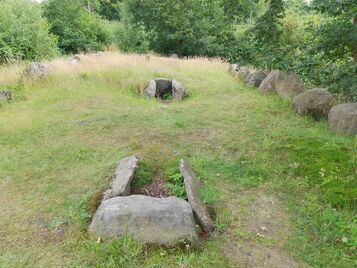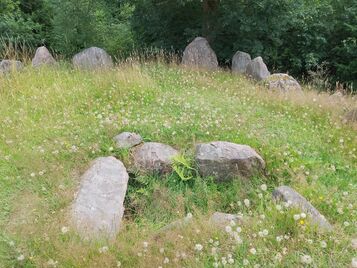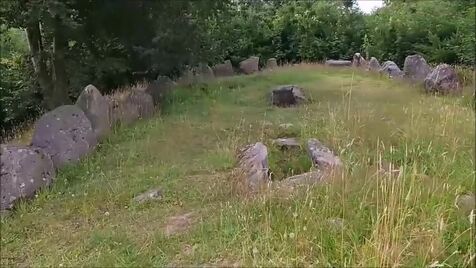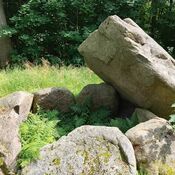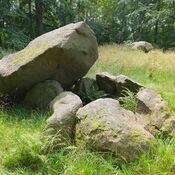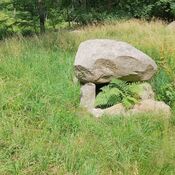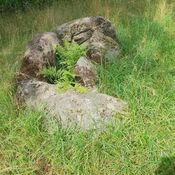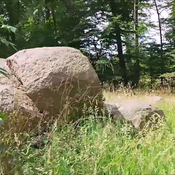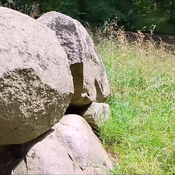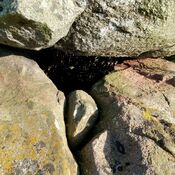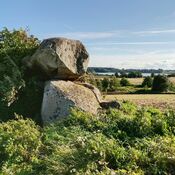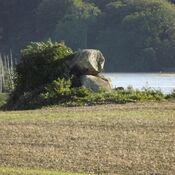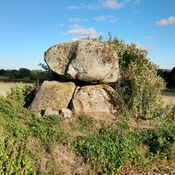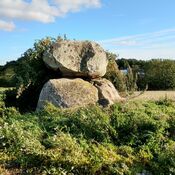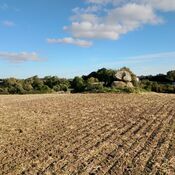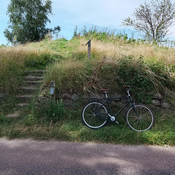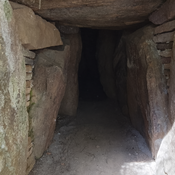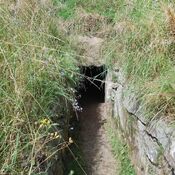Er zijn nog geen Nederlandstalige annotaties. Hier volgen annotaties in het Engels.
Den store langdysse is located in Pipstorn Skov (Pipstorn forest) within the Faaborg-Midtfyn Municipality. It is administratively protected, having been designated as protected before 1937 (Fredet før 1937). The responsible museum for the area is Arkæologi Sydfyn. Routine periodic surveillance of the protected locality has been conducted by Museum Odense in recent years (2009, 2021).
The monument is dated to the Stone Age, specifically between 3950 and 2800 BC. It is also described as being built some 5000 to 6000 years ago in the early Neolithic.
The monument is an impressive long dolmen (langdysse). It measures approximately 0.8–1.0 m high, 9–10 m wide, and 35–36 m long, oriented northwest-southeast (NV-SØ). After restoration, dimensions were recorded as 1.7 m x 33.0 m x 9.0 m.
The barrow features an imposing chain of re-erected kerbstones, which originally were described as being very large, with many having been overturned or possibly fractured before restoration. The monument is currently accessible via a marked path and has an informative sign.
The long barrow contains three rectangular burial chambers, all of which lack capstones (dæksten/overligger).
The three chambers are characterized as follows:
Two older chambers: These are rectangular, quite narrow, and aligned along the direction of the mound. They are believed to represent the oldest types of dolmen chambers. The northwestern (NV) and middle chambers follow this orientation (NV-SØ).
One younger chamber: This chamber is also rectangular but slightly larger and lies across the mound (NØ-SV orientation).
The chambers were originally constructed for a single person, possibly a chieftain of one or more settlements, but were nearly always reused multiple times.
The monument has a history of documentation, including museum surveys (Museal berejsning) starting in 1878 and continuing in 1886 and 1947. It underwent registration (Tinglysning) in 1886 and 1948.
The long barrow was beautifully restored in 1954 by Fyn Stiftmuseum. During this restoration, stones that had moved or turned over were erected and aligned. Although some soil is still lacking around the chambers, the dolmen is now "almost as it was when built".
Regarding artifacts:
Grave Finds: There are no known grave finds from the cairn.
Local Legend: Local accounts suggest that King Frederik the 7th excavated the chambers, but no written record confirms this.
Restoration Finds: During the restoration process, two flint axes and two flint chisels were discovered by the kerbstones outside the cairn. These items represent sacrifices that were part of the death cult during the passage-grave era (3200–2800 BC). The presence of these axes indicates that the cairn was in use for a long period of time.
The monument is considered noteworthy and instructive, particularly due to its relationship with the other ancient monuments found in Pipstorn.
https://youtu.be/RRmX0muexpY
https://www.kulturarv.dk/fundogfortidsminder/Lokalitet/8087/
Den store langdysse is located in Pipstorn Skov (Pipstorn forest) within the Faaborg-Midtfyn Municipality. It is administratively protected, having been designated as protected before 1937 (Fredet før 1937). The responsible museum for the area is Arkæologi Sydfyn. Routine periodic surveillance of the protected locality has been conducted by Museum Odense in recent years (2009, 2021).
The monument is dated to the Stone Age, specifically between 3950 and 2800 BC. It is also described as being built some 5000 to 6000 years ago in the early Neolithic.
The monument is an impressive long dolmen (langdysse). It measures approximately 0.8–1.0 m high, 9–10 m wide, and 35–36 m long, oriented northwest-southeast (NV-SØ). After restoration, dimensions were recorded as 1.7 m x 33.0 m x 9.0 m.
The barrow features an imposing chain of re-erected kerbstones, which originally were described as being very large, with many having been overturned or possibly fractured before restoration. The monument is currently accessible via a marked path and has an informative sign.
The long barrow contains three rectangular burial chambers, all of which lack capstones (dæksten/overligger).
The three chambers are characterized as follows:
Two older chambers: These are rectangular, quite narrow, and aligned along the direction of the mound. They are believed to represent the oldest types of dolmen chambers. The northwestern (NV) and middle chambers follow this orientation (NV-SØ).
One younger chamber: This chamber is also rectangular but slightly larger and lies across the mound (NØ-SV orientation).
The chambers were originally constructed for a single person, possibly a chieftain of one or more settlements, but were nearly always reused multiple times.
The monument has a history of documentation, including museum surveys (Museal berejsning) starting in 1878 and continuing in 1886 and 1947. It underwent registration (Tinglysning) in 1886 and 1948.
The long barrow was beautifully restored in 1954 by Fyn Stiftmuseum. During this restoration, stones that had moved or turned over were erected and aligned. Although some soil is still lacking around the chambers, the dolmen is now "almost as it was when built".
Regarding artifacts:
Grave Finds: There are no known grave finds from the cairn.
Local Legend: Local accounts suggest that King Frederik the 7th excavated the chambers, but no written record confirms this.
Restoration Finds: During the restoration process, two flint axes and two flint chisels were discovered by the kerbstones outside the cairn. These items represent sacrifices that were part of the death cult during the passage-grave era (3200–2800 BC). The presence of these axes indicates that the cairn was in use for a long period of time.
The monument is considered noteworthy and instructive, particularly due to its relationship with the other ancient monuments found in Pipstorn.
https://youtu.be/RRmX0muexpY
https://www.kulturarv.dk/fundogfortidsminder/Lokalitet/8087/

